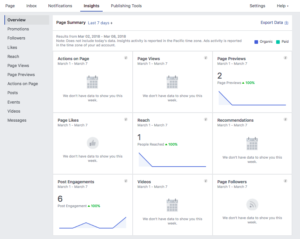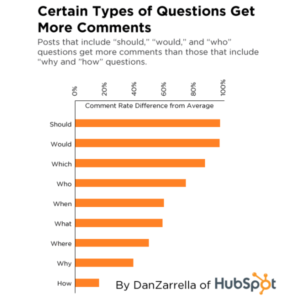
As Facebook continues to change its algorithms to improve user experience, it gets harder for digital marketers to effectively increase Facebook reach. This quick guide to fan reactions will help you increase Facebook reach by describing the do’s and don’ts of motivating your fans to do more than just “like” your posts. First, here’s a bit of background so you understand how Facebook got to where we are now.
From Facebook likes to loves
Facebook first introduced new fan reactions in 2016: love, sad, haha, wow, and angry. At the time, Facebook’s product design director explained that people were asking for more ways to express themselves. After many prototypes and extensive testing, they rolled out the reactions we know today.

At the time, Facebook signaled that all reactions would initially be ranked the same, but that they planned to monitor the change and make adjustments.
“In the beginning, it won’t matter if someone likes, “wows” or “sads” a post—we will initially use any Reaction similar to a Like to infer that you want to see more of that type of content. Over time we hope to learn how the different Reactions should be weighted differently by News Feed to do a better job of showing everyone the stories they most want to see.”
— Sammie Krug, Facebook Product Manager (2016)
At the start of 2018, Facebook made further changes to its algorithm, announcing that the traditional “like” would be assigned less value. Now, the system gives more weight to the new reactions. It also prioritizes posts from friends, family, and groups. That means it’s more important than ever to ensure that your Facebook content will generate the reactions you need, including comments and shares, to stay relevant to your fans.
Five Quick Tips on How to Increase Facebook Reach
Quick Tip #1: Do publish high-quality content
To effectively increase Facebook reach, quality matters most. Quality has always been the top consideration, but with the recent changes, you should ensure that everything you post adds value to your audience. Update your buyer personas, choose relevant topics to post about, and edit with a sharper pencil. Show personality in your posts and use them to tell a story. Be sure to include relevant images to make your posts look attractive.
Stuck on how to take your quality to the next level? You don’t have to reinvent the wheel! Use Facebook’s page Insights to find out which posts performed best and aim to replicate the approach you took in those. If your older posts are still relevant, you might even consider resharing them.

In addition to sharing your own high-quality content, you can also share great content from others. This also has an added bonus: they might reciprocate and share your content too! Partnering with other organizations is a great way for both of you to improve your Facebook engagement!
Quick Tip #2: Do harness the power of video
It’s no secret that video has taken off as the best way to increase Facebook reach in 2018. We’ve written before about why video sharing is essential for your digital strategy. Video is especially relevant to the new Facebook algorithm because research shows that people are more likely to react to a video than to images or text.
Facebook’s own best practices for video recommend that you use your first few seconds wisely, including beautiful imagery and captions, because Facebook videos autoplay with the sound muted. And since most Facebook users watch videos on their mobile device, your videos need to be optimized for mobile. Here is a short video with some additional quick tips on making videos that will attract your audience’s attention:
https://www.youtube.com/watch?v=cq8CHIpLHgE
As this Forbes article describes, storytelling makes customers more likely to engage with content, so your videos should have a storyline that your customers identify with. This applies to video content as well as text articles.
Quick Tip #3: Don’t encourage inauthentic fan interactions
When Facebook introduced these changes, some marketers tried to increase Facebook reach by directly asking people to react to a post in a certain way. For example, “Click love if you agree and angry if you disagree with this statement.” This seemed clever at first, but it’s important to understand that Facebook is aiming to improve the user experience, and most users see this approach as too gimmicky. Don’t try to circumvent the system by encouraging inauthentic fan reactions.
Remember that Facebook rewards authentic engagement that grows organically from fans. Instead of gimmicks, focus on Quick Tips #1 and #2 above, and generate high-quality content that people want to share. As mentioned above, look back at your past posts that received a lot of shares. Study what made those attractive and aim to do more of that.
Quick Tip #4: Do add more content that people will “love”
In the year after Facebook introduced the new fan reactions, the “love” reaction accounted for more than half of the 300 billion reactions used globally. While we shouldn’t be overzealous in directing fans to react in a certain way, there’s nothing wrong with posting material that you hope your audience will more than “like.”
Which posts get the most love? Posts with images and video perform well. So do posts that include the most interesting information in the all-important first few lines of the post. Trying starting with a question or an interesting fact or statistic. This piece provides some great tips on how to write Facebook posts using best practices for 2018, as well as this handy cheat-sheet.

No matter what approaches you try, your goal is to get the reader’s attention quickly and keep it, all while being authentic.
Quick Tip #5: Do stay on top of trends
Just because something is working well today doesn’t mean it will always work. Succeeding in social media means always trying to stay on the cutting edge of what’s happening. In addition to monitoring your own performance, also look at high-performing posts on your competitors’ pages and see what works for them. This is all part of staying on top of changes in the social media landscape and trends in your industry.
Don’t worry, though, this doesn’t have to be time-consuming. Choose a handful of blogs to follow on a regular basis (may we recommend ours as a starting point?), and schedule time for yourself each week—30 minutes to an hour at most—to review them. Don’t think of this time as unproductive. It is a critical part of your business development work! High-quality blogs will link to other sources of relevant and valuable information that you can also read if time permits. This small investment of time will help keep you on top of your social game.
Is there anything else you want to know about how to increase your Facebook engagement? Let us know in the comments!